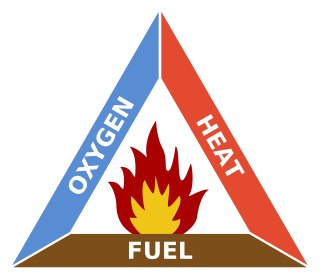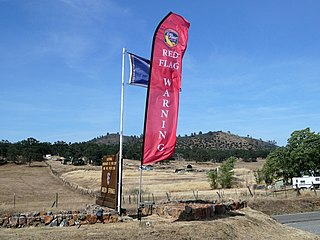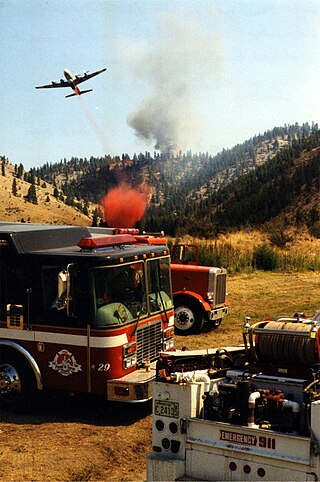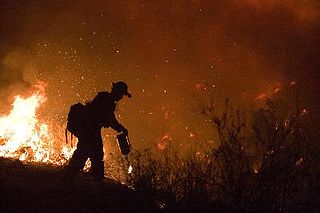Related Research Articles

The fire triangle or combustion triangle is a simple model for understanding the necessary ingredients for most fires.
Firefighting jargon includes a diverse lexicon of both common and idiosyncratic terms. One problem that exists in trying to create a list such as this is that much of the terminology used by a particular department is specifically defined in their particular standing operating procedures, such that two departments may have completely different terms for the same thing. For example, depending on whom one asks, a safety team may be referred to as a standby, a RIT or RIG or RIC, or a FAST. Furthermore, a department may change a definition within its SOP, such that one year it may be RIT, and the next RIG or RIC.
This glossary of wildfire terms is a list of definitions of terms and concepts relevant to wildfires and wildland firefighting. Except where noted, terms have largely been sourced from a 1998 Fireline Handbook transcribed for a Conflict 21 counter-terrorism studies website by the Air National Guard.
The Forest fire weather index (FWI) is an estimation of the risk of wildfire computed by Météo France and the Meteorological Service of Canada. It was introduced in France in 1992 but is based on a Canadian empirical model developed and widely used since 1976.

A red flag warning is a forecast warning issued by the National Weather Service in the United States to inform the public, firefighters, and land management agencies that conditions are ideal for wildland fire combustion, and rapid spread. After drought conditions, when humidity is very low, and especially when there are high or erratic winds which may include lightning as a factor, the Red Flag Warning becomes a critical statement for firefighting agencies. These agencies often alter their staffing and equipment resources dramatically to accommodate the forecast risk. To the public, a Red Flag Warning means high fire danger with increased probability of a quickly spreading vegetation fire in the area within 24 hours.

Wildfire suppression is a range of firefighting tactics used to suppress wildfires. Firefighting efforts in wild land areas require different techniques, equipment, and training from the more familiar structure fire fighting found in populated areas. Working in conjunction with specially designed aerial firefighting aircraft, these wildfire-trained crews suppress flames, construct fire lines, and extinguish flames and areas of heat to protect resources and natural wilderness. Wildfire suppression also addresses the issues of the wildland–urban interface, where populated areas border with wild land areas.

The Yellowstone fires of 1988 collectively formed the largest wildfire in the recorded history of Yellowstone National Park in the United States. Starting as many smaller individual fires, the flames quickly spread out of control due to drought conditions and increasing winds, combining into several large conflagrations which burned for several months. The fires almost destroyed two major visitor destinations and, on September 8, 1988, the entire park was closed to all non-emergency personnel for the first time in its history. Only the arrival of cool and moist weather in the late autumn brought the fires to an end. A total of 793,880 acres (3,213 km2), or 36 percent of the park, burned at varying levels of severity.
A Fuel Model is a stylized set of fuel bed characteristics used as input for a variety of wildfire modeling applications. Wildfire behavior models, such as those of Rothermel, take into account numerous empirical variables. While these inputs are important for equation outputs, they are often difficult and time-consuming, if not impossible, to measure for each fuel bed. A fuel model defines these input variables for a stylized set of quantitative vegetation characteristics that can be visually identified in the field. Depending on local conditions, one of several fuel models may be appropriate. As Anderson states “Fuel models are simply tools to help the user realistically estimate fire behavior. The user must maintain a flexible frame of mind and an adaptive method of operating to totally utilize these aids". Furthermore, depending on the application, the user must choose a fuel model classification system. The major classification systems for use in the United States include the National Fire Danger Rating System, the 13 ‘original’ fuel models of Anderson and Albini, the subsequent set of 40 fuels produced by Scott and Burgan, and the Fuel Characteristics Classification System.
The Keetch–Byram drought index, created by John Keetch and George Byram in 1968 for the United States Department of Agriculture's Forest Service, is a measure of drought conditions. It is commonly used for the purpose of predicting the likelihood and severity of wildfire. It is calculated based on rainfall, air temperature, and other meteorological factors.
The Ignition Component (IC) is a number which relates the probability that a fire will result if a firebrand is introduced into a fine fuel complex. It is a component of the NFDRS-National Fire Danger Rating System.
Burning Index (BI) is a number used by the National Oceanic and Atmospheric Administration (NOAA) to describe the potential amount of effort needed to contain a single fire in a particular fuel type within a rating area. The National Fire Danger Rating System (NFDRS) uses a modified version of Bryam's equation for flame length – based on the Spread Component (SC) and the available energy (ERC) – to calculate flame length from which the Burning Index is computed.
Spread Component (SC) is a rating of the forward rate of spread of a headfire. Deeming states that "the spread component is numerically equal to the theoretical ideal rate of spread expressed in feet-per-minute."
The energy release component (ERC) is a number related to the available energy (BTU) per unit area within the flaming front at the head of a fire. Daily variations in ERC are due to changes in moisture content of the various fuels present, both live and dead. Since this number represents the potential "heat release" per unit area in the flaming zone, it can provide guidance to several important fire activities. It may also be considered a composite fuel moisture value as it reflects the contribution that all live and dead fuels have to potential fire intensity. The ERC is a cumulative or "build-up" type of index. As live fuels cure and dead fuels dry, the ERC values get higher, thus providing a good reflection of drought conditions. The scale is open-ended or unlimited and, as with other NFDRS components, is relative. Conditions producing an ERC value of 24 represent a potential heat release twice that of conditions resulting in an ERC value of 12.

The state of Victoria in Australia has had a long history of catastrophic bushfires, the most deadly of these, the Black Saturday bushfires of 2009 claiming 173 lives. Legislation, planning, management and suppression are the responsibilities of the Victorian State Government through its departments and agencies including the Country Fire Authority (CFA) and the Department of Environment, Land, Water and Planning (DELWP).

Bushfires in Australia are a widespread and regular occurrence that have contributed significantly to shaping the nature of the continent over millions of years. Eastern Australia is one of the most fire-prone regions of the world, and its predominant eucalyptus forests have evolved to thrive on the phenomenon of bushfire. However, the fires can cause significant property damage and loss of both human and animal life. Bushfires have killed approximately 800 people in Australia since 1851, and billions of animals.

A Wildland fire module (WFM), formerly fire use module (FUM), is a 7–10 person team of firefighting personnel dedicated to planning, monitoring and starting fires. They may be deployed anywhere in the United States for resource benefits, prescribed fire and hazard fuel reduction projects.
The McArthur Forest Fire Danger Index (FFDI) was developed in the 1960s by CSIRO scientist A. G. McArthur to measure the degree of danger of fire in Australian forests. The index combines a record of dryness, based on rainfall and evaporation, with meteorological variables for wind speed, temperature and humidity.
The wildland–urban interface (WUI) is a zone of transition between wilderness and land developed by human activity – an area where a built environment meets or intermingles with a natural environment. Human settlements in the WUI are at a greater risk of catastrophic wildfire.

Wildfires are outdoor fires that occur in the wilderness or other vast spaces. Other common names associated with wildfires are brushfire and forest fire. Since wildfires can occur anywhere on the planet, except for Antarctica, they pose a threat to civilizations and wildlife alike. In terms of emergency management, wildfires can be particularly devastating. Given their ability to destroy large areas of entire ecosystems, there must be a contingency plan in effect to be as prepared as possible in case of a wildfire and to be adequately prepared to handle the aftermath of one as well.

Pyrogeography is the study of the past, present, and projected distribution of wildfire. Wildland fire occurs under certain conditions of climate, vegetation, topography, and sources of ignition, such that it has its own biogeography, or pattern in space and time. The earliest published evidence of the term appears to be in the mid-1990s, and the meaning was primarily related to mapping fires The current understanding of pyrogeography emerged in the 2000s as a combination of biogeography and fire ecology, facilitated by the availability of global-scale datasets of fire occurrence, vegetation cover, and climate. Pyrogeography has also been placed at the juncture of biology, the geophysical environment, and society and cultural influences on fire.
References
- ↑ Keetch, John J; Byram, George. 1968. A drought index for forest fire control. Res. Paper SE-38. Asheville, NC: U.S. Department of Agriculture, Forest Service, Southeastern Forest Experiment Station. 32 pp. (Revised 1988).
- 1 2 3 National Fire Danger Rating System (NFDRS) / John Wiley & Sons, Inc. doi : 10.1002/0471743984.vse8649
- 1 2 Burgan, Robert E. 1988. 1988 revisions to the 1978 National Fire-Danger Rating System. Res. Pap. SE-273. Asheville, NC: U.S. Department of Agriculture, Forest Service, Southeastern Forest Experiment Station. 39 pp. http://www.treesearch.fs.fed.us/pubs/593
- ↑ https://www.nwcg.gov/sites/default/files/products/pms932.pdf [ bare URL PDF ]
- ↑ (Deeming and others 1977, Bradshaw and others 1984).
- ↑ "Error 403 is HTTP_FORBIDDEN Redirect Page".
- ↑ "Error 403 is HTTP_FORBIDDEN Redirect Page".
- ↑ https://gacc.nifc.gov/rmcc/predictive/nfdrs_gaining_understanding.pdf Gaining and Understanding of the National Fire Danger Rating System. NWCG PMS 932 July 2002
- ↑ WFAS – Wildland Fire Assessment System